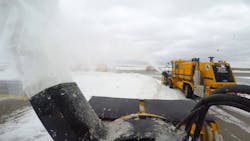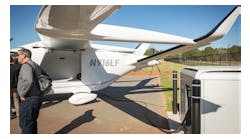Rick Husband Amarillo International Airport (AMA) in Amarillo, Texas, plans to upgrade its snow removal equipment facility to enhance its operations. Located in the panhandle area of Texas, Amarillo sees about 19 inches of snow annually and also contends with high winds.
Tyler Hurst, deputy director of aviation for AMA, said the airport began assessing its snow removal equipment in 2014 due to the age and challenges presented in usage and repairs.
“We had problems with mechanical equipment and sustainability. Sometimes it would work, sometimes it wouldn’t and it was really difficult to source parts,” he said. “They had reached the end of life and their value in terms of how they mechanically removed snow, ice and water was deteriorated.”
The airport purchased two new Oshkosh brooms in 2015 and two Oshkosh snow blowers in 2016. Both were financed using Federal Aviation Administration (FAA) grants. AMA didn’t increase its equipment levels, having six plows also part of its snow removal fleet.
“We have two 2006 Oshkosh plows, then we have a couple that we’re looking at replacement at some point with future grant initiatives,” Hurst said. “We still have two 1989 Walter plows and a couple of 1993 plows that we’d be looking at upgrading sometime in the future.”
Hurst said the airport hasn’t needed to use the snow blowers yet, but the new brooms are a substantial improvement compared to the old equipment.
“The brooms, being able to travel at roughly 50 miles per hour to get the contaminants off the runway or taxiways has definitely improved,” he said. “The old brooms, the broom implements, turned at such a low RPM and were so slow going that sometimes it kind of made it worse.”
Hurst said the airport completed upgrades to the fire suppression system in its snow removal equipment storage facility by upgrading suppression heads in 2018. Now the airport is working with RS&H on design to upgrade the roof of the facility and lighting upgrades. He said the airport wants to go to the FAA in 2018 with 100 percent full design of the project to request funding so AMA can go out to bid.
The building houses snow removal equipment, other maintenance equipment, a mechanic’s shop, and break room and sleeping quarters for snow removal operations.
“Amarillo has a lot of high winds and we’re looking at different styles and design some building efficiencies in terms of how we roof the building and all of the expenditures that we were spending in terms of electrical and other utilized to heat the building in winter and cool it,” Hurst said.
Hurst said the airport discovered it also needs a bigger footprint inside the building to store equipment and cost-effective ways to accomplish the goal. He said they’re designing a lean-to type structure to provide more covered parking spaces directly outside of the facility, which would increase capacity.
Hurst said prior coordination with your local FAA program manager to communicate your needs of the facility upfront is very helpful when starting to upgrade snow removal facilities.
He said it’s also imperative to get staff involved with upgrading snow removal facilities and equipment to find out their needs from an operator standpoint because they’re doing the work.
“A lot of times I think everyone is just concerned with primarily about the regulatory standpoint and that’s important for compliance, but at the end of the day, if you have the equipment and resources needed for the staff to accurately complete their job, I think that’s one of the most satisfying things that I can see,” Hurst said.
“Essentially, they’re the ones doing the work, so they’re the ones that matter,” he said.
An Eye on All Seasons
Patricia Lardie, strategic government accounts manager for Case IH, said more airports are asking for versatility when it comes to snow removal equipment.
The Spokane International Airport (SIA) in April took delivery of a Case Steiger Quad/Grouser blade system, which utilizes a 30-foot ramp blade to clear snow from paved and grassy areas without creating divots interfering with the ILS.
The unit also includes as three-point hitch/drawbar to allow it to pull a tillage unit to incorporate recycled deicing fluid in the spring. The unit allows the airport to attach up to 40’ rotary cutters and finishing mowers to the back in summer months to perform maintenance of grass areas, which Lardie said allows the airport to eliminate up to one day and one tractor and driver per mowing cycle during the mowing season.
“With the tracks, they will be able to mow earlier than they could with wheeled tractors,” she said. “And with it having tracks it doesn’t create the ruts out in the rough areas. It can go into fairly wet areas with high flotation.”
Lardie said Portsmouth International Airport at Pease (PSM) was the first airport to inquire about using the Quad tractor while at ConExpo and later purchased. Massport has also added the equipment to its ranks.
“The interest that was first shown in the unit is it’s a very large tractor and it can handle a very large blade,” she said. “The big interest to the Pease folks was the low-ground PSI,”
SGS Makes a Move to the Future
At South St. Paul Municipal Airport (SGS) is South St. Paul, Minnesota, the airport used a $219,267 FAA grant to purchase new snow removal equipment.
Joseph Carney, interim airport manager for SGS said snow removal tactics have been standard for quite a few years. Staff uses the loader for the majority of heavy snow moving on the runway, all the taxiways and the ramp. They then use a Ford F-550 with a plow on all of the taxi lanes and around the hangars.
They windrow all the snow in the middle of the taxiways, then a loader comes back with a 16-foot pusher box and clean the windrow up to the end of the taxi lanes to pile all the snow on the grass at the end.
Carney said after the plow goes through on the runway, staff goes through with a John Deere 6115M Tractor with a 12-foot wide sweepster broom attached and sweep the entire runway.
“We’ll sweep it so 90 percent of the snow is off. Anything left is just particles that have blown from the sweeper,” he said. “All the heavy chunks of snow are gone. What we’re trying to do is get down to the tarmac so within a day the runway is clean a dry.”
“With three people it would take us about two days to get a good snowfall taken care of,” he said. “With two of us, it takes us about four days to get everything done and cleaned to our satisfaction.
During the Super Bowl celebrations in Minneapolis, Carney said they had planes come in right after snow ended the Saturday before the game. Within an hour after the snow ended, staff had the runway and one taxiway cleared and swept so the aircraft could get to the ramp.
“We can get stuff done so we can move aircraft within two to three hours at the end of snowfall, Carney said.
The FAA grant was put to a new Caterpillar 938 loader, a new Falls plow and Ravling 16 foot pusher box into service.
“We felt we got the most bang for our buck with the Caterpillar,” he said.
Carney said the airport submitted a purchase proposal in late August, but didn’t get the equipment until the end of December.
“We were using old equipment that was falling apart to start the season, then we got this equipment and it was just in time,” he said. “Right after that, we’ve been having snow every other week since then.”
Carney said the wing was mounted to the front blade on the old loader, but it’s hard mounted to the Caterpillar on the new one, so there was a little bit of an adjustment in using it compared to the old equipment.
Carney said the airport is also planning to replace its 24-year-old plow and spreader this year as well. The airport will go from an F-550 to F-350 and a new plow that can curve.
“That will help us a lot around the hangars because we will be able to scoop the snow and push it away from the hangar instead just plowing the snow and using the angle of the blade to pull the snow away,” he said “We find we leave a lot of snow against the hangar and we just can’t get that close to it.”
Cleveland Brings Equipment Indoors
Cleveland Hopkins International Airport (CLE) opened a new 97,000 square foot snow removal equipment storage facility in December, which allows it to keep all of its equipment housed inside when not in use.
Renato Camacho, chief of planning and engineering for the Cleveland Airport System, said leaders started looking at its facilities in 2016 ago to determine how to store future snow removal equipment. About two-thirds of the equipment was stored indoors, but FAA inspectors said the entire fleet needed to be covered when not in use.
The airport looked at various areas around the airport for the new facility and determined it was best to next to the existing consolidated maintenance facility site to provide additional room. After looking at the facility and other sites at CLE and gathering input from employees, Camacho said they determined the existing site would work, but it needed to be expanded to meet FAA requirements.
“The city traditionally embarks on design-bid-build initiatives and we were able to convince them that the design-build initiative—based on scope, based on schedule, we wanted to expedite the schedule to meet FAA requirements for housing this additional equipment — we wanted to expedite construction,” he said. “So we selected this site and basically the scope of work entailed attaching the expanded facility to the north end of the existing consolidated maintenance facility.”
The construction project was awarded in June to Anthony Allega Cement Contractor Inc. The facility is 21 feet tall; has 32 doors; and includes a 20,000 gallon underground fuel tank with six dispensers capable of pumping 30 gallons per minute.
Camacho said storing the equipment inside will extend the lifecycle.
“One of the key components of this, with the existing CMS, depending on the vehicle, especially the multipurpose vehicles, they would have to detach some of the components of those multipurpose vehicles before they could enter them into the building,” Camacho said. “With the new building, because of the additional footprint both in an east-west and north-south direction, they no longer have to do that.”
The project took 180 days to complete and cost $17.3 million. The airport looked at various sites for the snow removal equipment facility, but settled on the consolidated maintenance facility area to keep operations from being bifurcated.
“We wanted to be able to complete this project by the end of December 2017,” Camacho said.
Camacho said the airport discovered during construction the airfield drawings were not as accurate as they should have been, which led to some utility conflicts. They were able to overcome the challenges and keep it on budget.
Camacho said the airport also decided to move its vehicle maintenance facility to a facility on the south side of the existing consolidated maintenance facility. The old facility was located on the other side of the airport campus, so operators had to drive equipment 2 miles across CLE whenever they experiences issues.
The new 28,000 square foot vehicle maintenance facility includes 14 doors and a truck wash.
“You basically have the existing facility sandwiched in between to expanded facilities, the snow removal equipment on the north end and the vehicle maintenance facility on the south end,” Camacho said.
By eliminating the old maintenance facility, Port Control Director Robert Kennedy said it has opened a site CLE plans to use to house either an airline or corporate use.
“We think it’s a prime location of the airfield either for corporate aircraft or maintenance,” he said.
The existing consolidated maintenance facility is on a linear site on the west side of CLE and is about 20 years old. Footer and structural modifications were necessary where the new and old facilities met, which created some challenges.
Since coming online, Camacho said the snow removal has been working
“The guys are appreciating the vehicles being stored inside,” Kennedy said. “They can prep them to go out on the airfield all inside a climate controlled atmosphere and it really enhances their ability to check the equipment and prep it.”






